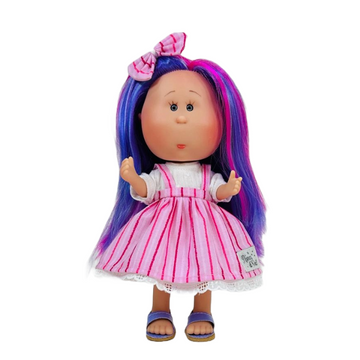The 9-Minute Rule for Dolls And Accessories
Table of Contents7 Simple Techniques For Dolls And AccessoriesThe Of Dolls And AccessoriesSee This Report on Dolls And AccessoriesDolls And Accessories for DummiesNot known Details About Dolls And Accessories 10 Simple Techniques For Dolls And AccessoriesSome Of Dolls And Accessories
When dolls are included in team play, children practice waiting, sharing, and listening to others' ideas. Whether they're pretending to be a moms and dad, sibling, or close friend, children discover just how relationships workhow to support others, fix arguments, and take care of somebody else. These early role-play experiences become the foundation for healthy friendships and relationships later in life.Repeating calming routines with a doll (feeding, rocking, closing) can help kids really feel tranquil and secure. These calming routines educate them just how to self-regulate. Caring for a doll can make a kid feel qualified and certain - high end dolls. It provides a feeling of duty and control in a world that typically really feels unpredictable.
The Greatest Guide To Dolls And Accessories
When children see dolls that show their race, heritage, and society, it strengthens a positive feeling of identification. It states, "You belong. Your tale matters." Dolls also introduce children to societies outside their own, building considerate inquisitiveness and compassion for others. This is where inclusive play can bring about comprehensive areas.
As Dr. Karyn Purvis, a leader in child advancement and trauma-informed care, when said: This effective quote highlights exactly how play isn't just funit's how children find out best. The mind cords itself through repeating. However when a youngster is engaged, joyful, and psychologically linked to an activitylike doll playthe mind reinforces those links much faster and extra meaningfully.
Unknown Facts About Dolls And Accessories

Boys need empathy, compassion, and creative imagination tooand doll play supplies that. Yesdolls use something distinct. They encourage open-ended narration and psychological connection in such a way few other playthings do. Dolls are frequently a kid's very first "buddy," assisting them practice partnerships, construct communication abilities, and feel comforted. Youngsters create their sense of self from a young age.
The Dolls And Accessories Diaries
With dolls that matter. Samantha Ong Samantha Ong is the founder of Joeydolls, a Canadian-based toy brand name on a goal to commemorate Oriental cultures with joyful, comprehensive play. Inspired by her very own experiences expanding up without social depiction, Samantha designs dolls that aid kids really feel proud of that they are while sparking inquisitiveness and compassion in others.
Having fun with dolls urges kids to speak even more about others' thoughts and feelings, a study has located. The research study suggests that playing imaginary video games with dolls could help kids create social skills, theory of mind and empathy. The neuroscientist who led the work claimed that the educational value of having fun with Lego and building playthings was widely approved, however the benefits of playing with dolls occasionally showed up to have been neglected."When kids create imaginary worlds and function play with dolls, they connect in the beginning aloud and afterwards internalise the message concerning others' thoughts, feelings and feelings," claimed Dr Sarah Gerson, a neuroscientist at Cardiff University and the lead author.
The smart Trick of Dolls And Accessories That Nobody is Talking About
They were additionally extra most likely to deal with the dolls in the 2nd person, talking with them straight, whereas the personalities on the computer display they tended to refer to in the 3rd person. No difference was observed in between kids and ladies."Internal state language can indicate that a child is assuming about other individuals's ideas and emotions while playing with dolls," claimed Gerson.
Which they see language usage in this regard is excellent confirmation click this site of the theory."Mardell added that the findings should relate to any type of kind of role-play plaything, rather than being specific to Barbies. "I would certainly take a broader sight of what a doll is," he claimed." [It can be] any type of item that the kid can invest a sense of other into a packed pet, an oven mitt that speaks to them, and even an imaginary friend."Kid normally start to show indicators of inner state language around the age of 4.
Some Ideas on Dolls And Accessories You Should Know
"It comes to be vital for making and maintaining relationships, and just how they gain from their teachers, and moms and dads."The research also found that the kids had raised mind task in the posterior premium temporal sulcus (pSTS) area when they spoke as though their dolls had thoughts and feelings. The pSTS area is believed to be entailed in the advancement of social and psychological handling skills.
Childhood years is not a static life phase; indeed, the definition, meaning and understanding of youth are all based on alteration. By the nineteenth century among the most extensive changes was the significance placed on allowing children to experience "the carefree pleasures" of childhood years with playtime activities. Play was currently taken into consideration to be a critical component of a great youth.
In order to completely recognize the definition of play, one must likewise recognize the value of the doll. However, dolls are far more than playthings made to amuse young women. During the 19th century correct play tasks were selected to promote intellectual, physical or emotional growth. Dolls were specifically preferred due to the fact that they were believed to promote and support womanly high qualities such as generosity, caring and concern.
Things about Dolls And Accessories

It is only through archaeological examinations that scientists can want to discover and record the full variety of playtime experiences. Chronicling these experiences, and especially the role of dolls, is important for presenting a more complete image of childhood years throughout the nineteenth century. Alarcn, Sara E - dolls., "Youngster's Play: The Function of Dolls in 19th Century Childhood" (2007 )